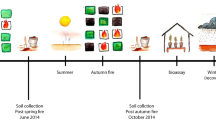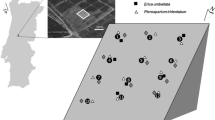Abstract
In an investigation of potential chemical activity of fire-sensitive shrubs in Florida's sand pine scrub community, bioassays of foliar washes ofConradina canescens showed significant inhibitory activity on three native grasses that are known to fuel frequent surface fires; inhibition was concentrated seasonally in spring and summer. Application of runoff fromConradina leaves to one of the grasses caused a 50% reduction in growth over a 20-week period. Isolation of the biologically active fractions from the fresh leaves ofC. canescens yielded numerous monoterpenes, a number of which were identified from a GC-MS reference library and/or MS comparison to authentic compounds: 11 from the diethyl ether extract, 11 from steam distillation, and four from the foliar leaf wash. Numerous other monoterpenes present in the extractions were unknown. The terpenoid fraction completely inhibited seed germination of one of the native grasses and of lettuce. Saturated aqueous solutions of nine of the monoterpenes inhibited germination and radicle growth of two native grasses. SEM views of the leaf surfaces ofConradina reveal secretory trichomes that appear to be the source of the monoterpenes as well as the triterpene, ursolic acid. The biological activity ofC. canescens as a fire-sensitive component of the scrub community is reviewed in light of the chemical evidence.
Similar content being viewed by others
References
Chapman, H.H. 1932. Is longleaf type a climax?Ecology 13:328–334.
de la Peña, A.C. 1985. Terpenoids fromConradina canescens (Labiatae) with possible allelopathic activity. MS thesis. Louisiana State University, Baton Rouge.
Fischer, N.H. 1986. The function of mono- and sesquiterpenes as plant germination and growth regulators, pp. 203–218,in A.R. Putnam and C. Tang (eds.). The Science of Allelopathy. Wiley, New York.
Fischer, N.H., Tanrisever, N., andWilliamson, G.B. 1988. Allelopathy in the Florida scrub community as a model for natural herbicide actions, pp. 232–249in H. Cutler (ed.). Biologically Active Natural Products: Potential Use in Agriculture. ACS Symposium Series No. 380. American Chemical Society, Washington, D.C.
Garren, K.H. 1943. Effects of fire on vegetation of the southeastern United States.Bot. Rev. 9:617–654.
Harper, R.M. 1915. The natural resources of an area in central Florida.Annu. Rep. Fla. State Geol. Surv. No. 13:71–301.
Hebb, E.A. 1982. Sand pine performs well in the Georgia-Carolina sandhills. SouthernJ. Appl. For. 6:144–147.
Laessle, A.M. 1958. The origin and successional relationship of sandhill vegetation and sand pine scrub.Ecol. Monogr. 28:361–387.
Metcalfe, C.R., andChalk, L. 1965. Anatomy of the Dicotyledons, Vol. II. Oxford on the Clarendon Press, London.
Muller, C.H. 1965. Inhibitory terpenes volatilized fromSalvia shrubs.Bull. Torrey Bot. Club 92:38–45.
Muller, C.H., anddel Moral, R. 1966. Soil toxicity induced by terpenes fromSalvia leucophylla.Bull. Torrey Bot. Club 93:332–351.
Muller, C.H., Muller, W.H., andHaines, B.L. 1964. Volatile growth inhibitors produced by shrubs.Science 143:471–473.
Muller, C.H., Hanawalt, R.B., andMcPherson, J.K. 1968. Allelopathic control of herb growth in the fire cycle of California chaparral.Bull. Torrey Bot. Club 95:225–231.
Nash, G.V. 1895. Notes on some Florida plants.Bull. Torrey Bot. Club 22:141–161.
NOAA. 1983. Climatological Data, Annual Summary, Florida 1983. National Oceanic and Atmospheric Administration, National Climatic Center, Ashville, North Carolina.
Richardson, D.R. 1977. Vegetation of the Atlantic Coastal Ridge of Palm Beach County, Florida.Fla. Sci. 40:281–330.
Richardson, D.R. 1985. Allelopathic effects of species in the sand pine scrub of Florida. PhD dissertation. University of South Florida, Tampa, 120 pp.
Veno, P.A. 1976. Successional relationships of five Florida plant communities.Ecology 57:498–508.
Webber, H.J. 1935. The Florida scrub, a fire-fighting association.Am. J. Bot. 22:344–361.
Whitney, M. 1898. The Soil of Florida.USDA (Soils) Bull. 13:14–27.
Williamson, G.B., andBlack, E.M. 1981. High temperatures of forest fires under pines as a selective advantage over oaks.Nature 293:643–644.
Williamson, G.B., andRichardson, D.R. 1988. Bioassays for allelopathy: Measuring treatment responses with independent controls.J. Chem. Ecol. 14:181–187.
Williamson, G.B., Richardson, D.R., andFischer, N.H. 1989. Allelopathic mechanisms in fire-prone communities, pp. XX-XX,in S.J.H. Rizvi (ed.) Frontiers of Allelochemical Research. Martinus Nijoff, The Netherlands (in press).
Author information
Authors and Affiliations
Rights and permissions
About this article
Cite this article
Williamson, G.B., Fischer, N.H., Richardson, D.R. et al. Chemical inhibition of fire-prone grasses by fire-sensitive shrub,Conradina canescens . J Chem Ecol 15, 1567–1577 (1989). https://doi.org/10.1007/BF01012384
Received:
Accepted:
Issue Date:
DOI: https://doi.org/10.1007/BF01012384




